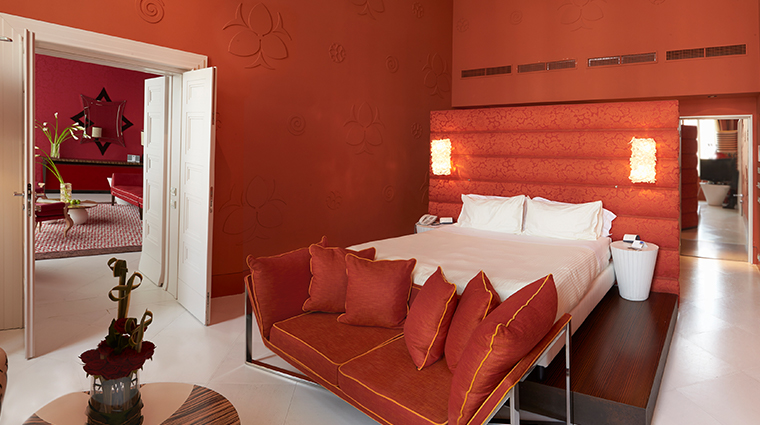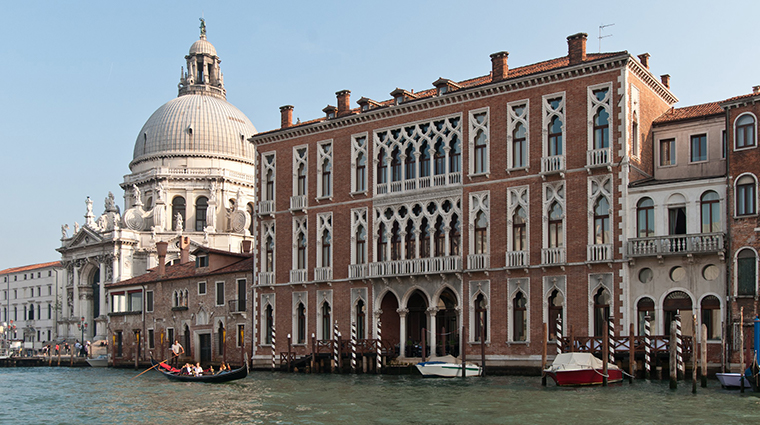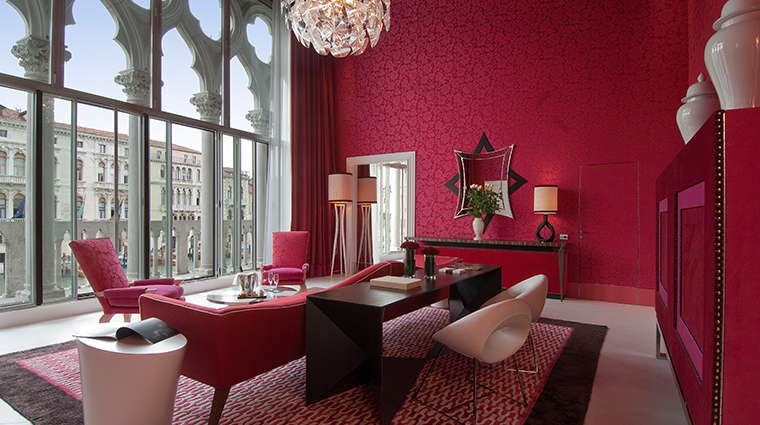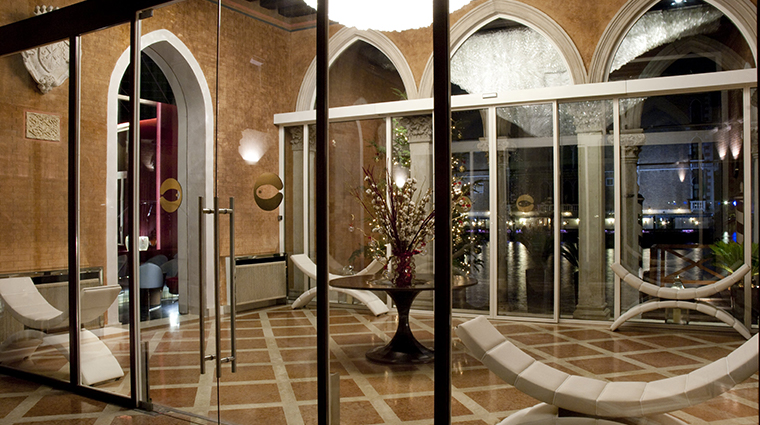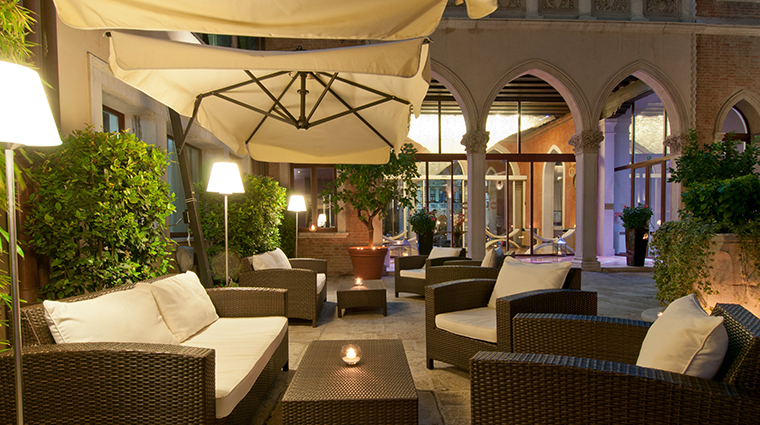Sina Centurion Palace
A modern addition to Venice's Museum Mile
Writer Truman Capote once quipped that “Venice is like eating an entire box of chocolate liqueurs in one go.” And if you’re sated with the Gothic and Renaissance palaces and churches, Sina Centurion Palace will give you a taste of something different.
This imposing neo-Gothic palace on the Grand Canal only looks old — it was built in 1892 for the Genovese family, but eventually was left empty until 2009, when Florentine architect Luigi Ciompi redesigned it as a hotel with a clean, contemporary touch that blends simplicity with luxury.
Colors, shapes and materials play together in a way that perfectly echoes its chic Dorsoduro neighbors on the so-called “Museum Mile,” which stretches from the Punta della Dogana and Peggy Guggenheim museums to the Accademia Gallery.
Some Venetian hotels overload the décor with every motif, but the Centurion has stripped them down to their essentials and makes the simple seem sumptuous.
This imposing neo-Gothic palace on the Grand Canal only looks old — it was built in 1892 for the Genovese family, but eventually was left empty until 2009, when Florentine architect Luigi Ciompi redesigned it as a hotel with a clean, contemporary touch that blends simplicity with luxury.
Colors, shapes and materials play together in a way that perfectly echoes its chic Dorsoduro neighbors on the so-called “Museum Mile,” which stretches from the Punta della Dogana and Peggy Guggenheim museums to the Accademia Gallery.
Some Venetian hotels overload the décor with every motif, but the Centurion has stripped them down to their essentials and makes the simple seem sumptuous.
Our Inspector's Highlights
- The wooden terrace on the Grand Canal is a wonderful summertime perch for drinks or even dinner. It’s well positioned to get sunshine in the morning and shade in the heat of the afternoon.
- The small bar has a trendy, uptown vibe but yet is somehow welcoming, with banquettes of crimson velvet and small angular chairs upholstered in aquamarine.
- Most of the public areas and some of the guest rooms have exceptionally high ceilings, adding a hint of the spectacular.
- The modern black coffered ceiling in the small lounge past the reception desk looks like iron, but is actually wood. It is a deft reinterpretation of the classic coffered ceilings seen elsewhere in the Venice hotel.
- The walls, from the small lounge to many of the hallways, are often concealed by velvet curtains, a touch that gives a subtly theatrical air in a city that looks like a stage set.
Things to Know
- There is a gondola traghetto, or ferry, that crosses the Grand Canal only a few steps from the luxury hotel. It’s the fastest and most Venetian way to cross this amazing waterway.
- Several interesting finds came to light during the restoration process, such as remains of a 7th-century stone house and 9th-century wooden home. Real people lived in ordinary dwellings here; it wasn’t all palaces.
- The greatest surprise during the restoration was a 2nd-century Roman coin showing the head of Antinous, the handsome young favorite of the Emperor Hadrian. The hotel restaurant Antinoo’s is named for this intriguing person who met an early and unexplained demise.
The Rooms
- The ceiling of a number of the top-floor rooms expose the original structural wooden beams that support the roof, turning a necessity into a beautiful angular design element.
- Four rooms are adapted for handicapped access, and every surface of the shower stall gleams with what appears to be gold leaf, giving an atmosphere of luxury to the simplest space.
- The color schemes are simple and original, with gold, aqua and terracotta (and sometimes orange) — shades that are not typically Venetian. They lend the rooms lightness and calm.
- The larger rooms and suites are elegant and inviting, but some of the smaller accommodations up under the roofbeams have a curious charm and intimacy that just cries out “honeymoon.”
Nearby Attractions
- The Punta della Dogana museum, housed in the Maritime Customs House of the Venetian Republic, was redesigned by Japanese architect Tadao Ando in 2009. It shows pieces from the private collection of French billionaire Francois Pinault, owner of one of the world’s largest modern art reserves.
- The Peggy Guggenheim Collection comprises extraordinary works of futurist and modern art. As of 2012, the collection was the most-visited art gallery in Venice and the 11th most visited in Italy.
- Don’t overlook the Palazzo Cini Gallery, a few minutes from the Guggenheim. It houses the astonishing collection of the late Venetian entrepreneur Vittorio Cini. The exhibition includes paintings (many of “Tuscan Primitives” such as Piero della Francesca, and many by famous Florentine and Ferrarese painters), sculptures, glass, porcelain, enamels, small bronzes, rugs, ivory and mirrors. Unlike many museums, it’s open Monday and closed Tuesday.
- Saverio Pastor (near the Guggenheim) is one of the few traditional makers of Venetian forcolas, the distinctive hand-carved wooden oarlocks used by gondoliers and others who row in the Venetian way. Designed for everyday uses, these objects are also works of art that have been displayed in many exhibitions.
Getting There
Dorsoduro, 173, 30123 Venice, Italy
TEL39-041-34281
TEL39-041-34281
NEARBY AIRPORT(S)
VCE ((25 min))
